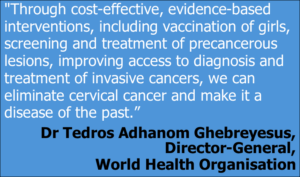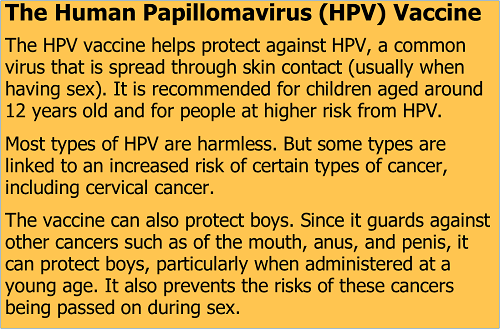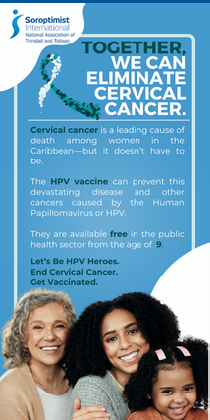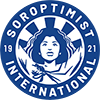 Cervical cancer is preventable and curable, as long as it is detected early and managed effectively.
Cervical cancer is preventable and curable, as long as it is detected early and managed effectively.
Yet it is the 4th most common form of cancer among women worldwide, with the disease claiming the lives of almost 350,000 women in 2022. Few diseases reflect global inequalities as much as cancer of the cervix. Nearly 94% of the deaths in 2022 occurred in low and middle income countries. This is where the burden of cervical cancer is greatest, because access to public health services is limited and screening and treatment for the disease have not been widely implemented.
Since 2023 Soroptimists have been working hard to raise awareness of the importance of screening for the disease and to encourage vaccination to completely eliminate it.
Putting Cervical Cancer in the Rear View Mirror
 Cervical cancer used to be a disease of older women who had never had a ‘smear test’. Today, there is a far better screening uptake and the peak age for cervical cancer is now 30-34 years.
Cervical cancer used to be a disease of older women who had never had a ‘smear test’. Today, there is a far better screening uptake and the peak age for cervical cancer is now 30-34 years.
In addition there is a vaccine that can be given to 12-13 year olds which would protect against cervical cancer. The HPV vaccine is not routinely offered but if it were administered worldwide to younger girls, along with screening for older women, cervical cancer could be eliminated by 2030. See the World Health Organisation’s Global Strategy for Cervical Cancer adopted in 2020.
According to a 2024 study funded by Cancer Research and published in The Lancet, offering the HPV vaccine to girls aged between 12 and 13 in the UK prevents almost 90% of cervical cancers. Cervical cancer rates in the UK have fallen by 25% since the early 1990s as a result of increased screening and the effects of the HPV vaccination. However, HPV vaccine coverage for both female and male students has decreased year on year since 2020.
Soroptimists call for
- Worldwide agreement to meet the WHO’s targets of ‘90-70-90’ which will result in incidents of cervical cancer below 4 per 100,000 women.
- Vaccination: 90% of girls fully vaccinated with the HPV vaccine by the age of 15.
- Screening: 70% of women screened using a high-performance test by the age of 35 and again by 45.
- Treatment: 90% of women with pre-cancer treated and 90% of women with invasive cancer managed.
- The UK NHS to review vaccination take up rates locally and set plans to achieve the 90% vaccination target, particularly among girls before year 10 (aged 14).
- The UK NHS to take robust action to meet it’s 80% screening target. Current data shows that 5 million women are not up to date and only 66% of 25-49 year olds have been screened.
- The NHS and government to pursue a public awareness campaign to get women behind the possibility to eradicate this cancer, encouraging improved screening and vaccination, particularly in low uptake areas and within low uptake groups
Our Programme Action

 Alongside our advocacy for change, Soroptimists are working hard to raise awareness within our own communities.
Alongside our advocacy for change, Soroptimists are working hard to raise awareness within our own communities.
SI Trinidad and Tobago for example, have worked tirelessly to talk to school children about the advantages of immunisation and have even created a graphic novel, HPV Heroes, Defenders of the Future, aimed at 12 year olds, to help explain in terms children can understand.
Together with a book launch, publicity materials and an awareness campaign, our members are supporting the drive to meet 90-70-90 targets on the islands.
If each country worldwide met the 90–70–90 targets by 2030, we could eliminate cervical cancer within the next century.
Some clubs nationally offer companionship and support to women who may, for reasons of language, vulnerability or other, not be able to attend GP practices themselves. Our members accompany these ladies to help them attend their appointments and get the help they need.
For more information on our project and advocacy work on Health click here.
For more information on our work on our charitable objects click here.
Read about our work to eradicate cervical cancer here.
Read how HPV Cancers also affect men and boys here.
Read our latest article for WHO Eliminate Cancer Day of Action here.


